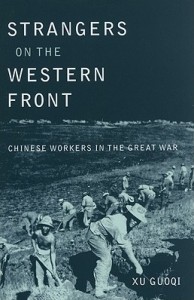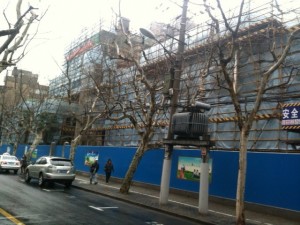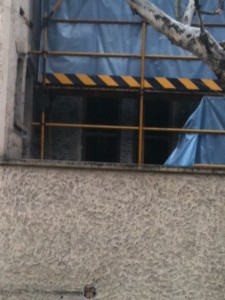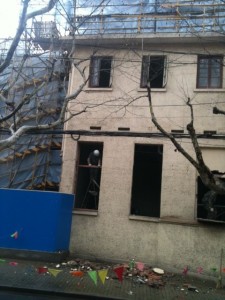Posted: March 31st, 2012 | No Comments »
Thinking back to my What We Lost Lists for Shanghai’s architecture one major area where there is a need for preservation is industrial architecture. Beijing tarted up an old factory complex for the 798 art district and Shanghai has 1933, the old Municipal abattoir – 798 has certainly been more of a hit than the invariably deserted 1933 I have to say. However, in general industrial architecture is rarely recognised as being important or worth using despite being eminently suitable for other purposes from shopping malls to nightclubs to niche luxury apartments.
I thought of this when wandering around the old St James Power Station in Singapore on a quick visit recently. the former power station, a modernist building, is now a complex of nightclubs and bars that really only comes alive at night and is sort of as racy as Singapore gets. It’s on the Keppel and is now overshadowed by the horror that is Sentosa nearby. They’ve got a web site explaining all that fun stuff here. The power station was built in 1927, it was Singapore’s first coal fired power plant supplying electricity to nearby shipyards, industry and residences. The station was shut in 1962 but fortunately not bulldozed. There’s a full history and more details of the building’s history here.
The problem for Shanghai is that most of the good industrial architecture that’s left is not in areas considered suitable for nightlife and redevelopment. It’s mostly down in Hongkou, or even further away in Yangpu. Many Shanghainese don’t travel to those areas and foreigners seem to consider pretty much anything in Shanghai north of the Suzhou Creek terra incognita! Still, the St James Power Station in Singapore does show what is possible with a little thought and creativity.




Posted: March 30th, 2012 | No Comments »
I recently had a great day at Carrick Hill (just outside Adelaide) with the great biographer Selina Hastings and the director and urge anyone in South Australia to visit if at all possible – Richard Heathcote, the director there, was a wonderful guide and it’s true (as he notes on his blog) we did become a bit over-absorbed in the great Stanley Spencer’s and Jakob Epstein’s to take in all the Chinoiserie too!!
Here’s Carrick Hill’s website – a gorgeous English style country house and gardens just a short taxi ride from downtown Adelaide
And here’s a blog post from Richard on the Chinoiserie in his collection that Selina and I rather missed due to our fascination and delight in discovering so much 1930s British art hanging on these walls in South Australia!
 Chinese jardiniere that is part of the Carrick Hill collection
Chinese jardiniere that is part of the Carrick Hill collection
Posted: March 29th, 2012 | No Comments »
As many of you will know China is the featured country at the London Book Fair this April – bad news as of course Beijing has sought to control the presentation of China at the event and LBF appear to have just let them (see this Guardian article for instance on how only state-approved writers will be appearing). So a stand has to be taken, however minor. Asian Arguments is a series of shorter books on China and Asia that I series edit with Zed Books – we’re having a gathering during LBF to celebrate diverse opinions and viewpoints on China that are without Beijing’s official view. And you’re invited – it’s at Probsthain’s, the great Asian specialist bookseller opposite the British Museum and there’ll be a drink or two and hopefully a good gathering of academics, writers, policy analysts and business people with a variety of view and contact points with China. So, for homogeneity Beijing style go to Earl’s Court for LBF, or come and join us for a drink (no long speeches guaranteed too). Details below and rsvp contact.

Tuesday 17th April
7pm – 9pm
Probsthains Book Shop
41 Great Russell Street
London WC1B 3PE
Chinese Publishing is the special focus of London Book Fair 2012.
Zed Books would like to invite you to a reception to celebrate the full range of Chinese voices and viewpoints whether they be from arts, academic or business backgrounds.
To supplement the London Book Fair which is an official occasion for promoting Chinese literature and long-lasting business partnerships with China, come to this informal event, which will encourage broad discussion. You will meet others who are also well-informed about China and its recent development.
You will also have the opportunity to browse and discuss Zed’s new Asian Arguments series, which is sponsoring the event.
We hope to see you there.
For more information, please contact Ruvani de Silva, Publicity Manager at Zed Books at ruvani.de_silva@zedbooks.net
Posted: March 29th, 2012 | No Comments »
Every time I visit Australia (happen to be spending a week in Melbourne at the moment) I find China books that I’d hadn’t been aware of. Peter Thompson’s Shanghai Fury: Australian Heroes of Revolutionary China is one such – probably deemed hard to promote outside Australia the title was always going to make me sit up and pay attention. I stumbled across it in a bookshop here and snapped it up straight away.
Among many attributes the book is a nice production, striking cover and a great set of photo plates inside

Shanghai is a city defined by war. The city and its armed struggles were central to the relationship between China and Australia from the fall of the Manchus in 1912 to the Communist victory in 1949. Yet with the notable exception of George ‘Chinese’ Morrison, the Australian contribution has been largely neglected and no single volume covers the experiences of the many remarkable Australians caught up in the drama.
Set against a backdrop of imperial splendour and abject squalor, Shanghai Fury examines one of the seminal periods of the 20th Century in a compellingly readable narrative that mixes personal memoir with combat action to complete a powerful trilogy on Australians at war.
Posted: March 28th, 2012 | No Comments »
I’ve heard about a whole bunch of books about the Chinese Labour Corps (the “Coolie Corps”), both the British and French corps, being released imminently. I suspect it’s a combination of this being a generally fascinating but overlooked subject as well as the centenary of the Great War approaching. The story of those Chinese hired and brought over to help ship armaments, clear the battlefields etc etc is compelling. Xu Guoqi’s book Strangers on the Western Front appears to have its flaws – not looking at the lives of these men is a serious omission as is not considering what became of them when they returned to China (many became the backbone of the warlord armies) or stayed on (forming part of the nascent Chinatowns of London and Paris). There appear to be a lot of unsubstantiated comments about the corps, its overseers and the war – I’ll get into all sorts of trouble but it has to be said that a lack of rigorous fact checking, rather sweeping generalisations and a tenancy to never criticize anything Chinese but find blame elsewhere is, all too often, the hallmarks of Chinese historians schooled in a highly politicised environment that sees getting the “line” correct more important than accuracy frequently. Still, any nuggets on the Corps are most welcome all the same.
There’s a more thorough review here on The China Beat

Posted: March 27th, 2012 | No Comments »
The old College Municipal Franciase on Nanchang Road (formerly Route Vallon) in Frenchtown metamorphosed into the Shanghai Science Hall and you used to be able to get in and walk around. It was a lovely building, a truly delightful campus style college building redolent of 1930s Shanghai. I mentioned in my round up of Shanghai’s architectural losses last year – What We Lost 2011 – the College Municipal Francaise was under wraps by the builders and who knew what was happening.
Well, I wandered past the other day and things look distinctly worrying, though not surprising. It appears that the entire interior has been ripped out now (as usual for “renovations”) and the window frames have also been removed (again par for the course for Shanghai “renovations”). Though I’m not expecting the structure to be pulled down we have to say that it has been gutted now.
 The College Municipal Francaise on Nanchang Road under wraps
The College Municipal Francaise on Nanchang Road under wraps
 Here you can see windows with the frames removed – rarely once removed do the originals get returned
Here you can see windows with the frames removed – rarely once removed do the originals get returned
 Here you see the adjoining building to the College being refurbished too – top right note the original wooden window frame remaining – the ground floor ones have been ripped out and trashed.
Here you see the adjoining building to the College being refurbished too – top right note the original wooden window frame remaining – the ground floor ones have been ripped out and trashed.
Posted: March 26th, 2012 | No Comments »
RAS WEEKENDER
Saturday 31st March 2012 at 4:00pm
No.8 Xintiandi North Part Lane 181 Taicang Road Shanghai
Address in Chinese: 太仓路181弄,新天地广场北里8å·,T8é¤åŽ…

PROFESSOR JEFFREY RIEGEL
on
Homicide, Homosexual Rape, and the Pursuit of Justice
in Early 19th Century China
Early nineteenth century Qing legal documents illustrate how judicial authorities struggled with and openly debated questions around how to make punishments fit the crimes of homicide and homosexual rape. In the course of their deliberations these officials reveal interesting insights into Qing dynasty attitudes toward same-sex relations, the equality of men and women, and the role of compassion in systems of adjudication. While Qing laws were generally promulgated to benefit the emperor and the state, they were interpreted and refined to reflect the realities of society and human nature.
Professor Jeffrey Riegel is Professor and Head of School of the School of Languages and Cultures, Faculty of Arts, Sydney University. Most of his 34-year academic career was spent at the University of California, Berkeley. He retired from the position of Agassiz Professor of Chinese in 2007. He travels frequently to China and has long been committed to helping bring about a greater understanding of China.
Entrance: RMB 80.00 (RAS members) and RMB 130.00 (non-members). Those unable to make the donation but wishing to attend may contact us for exemption, prior to the RAS Weekender event. Membership applications and membership renewals will be available at this event.
RSVP: “Reply” to this email or to RAS Bookings at: bookings@royalasiaticsociety.org.cn
Posted: March 24th, 2012 | 1 Comment »
I met an idiot the other day who insisted that Chinese people and their current fascination with luxury brands and expensive products was a new thing. What utter tosh…of course mainland Chinese people had no time or interest in luxury items during the horrors of the Mao years or the poverty that followed. Funnily enough filling your belly and keeping warm and alive took priority. However, of course people liked and appreciated fine things prior to the Maoist debacle of 1949, as did many Shanghailanders too. Rolex is one of those appreciations that seems to have jumped the nasty bit of Maoism in the middle. Alexander Clark was selling Rolex Oyster’s from Sassoon House (the shopping arcade and office portion of the Cathay Hotel on Nanking Road and the Bund, now renamed The Peace Hotel). This ad is from 1940 and a 1940 Rolex these days is a very nice thing to own!
 what utter tosh
what utter tosh












 what utter tosh
what utter tosh